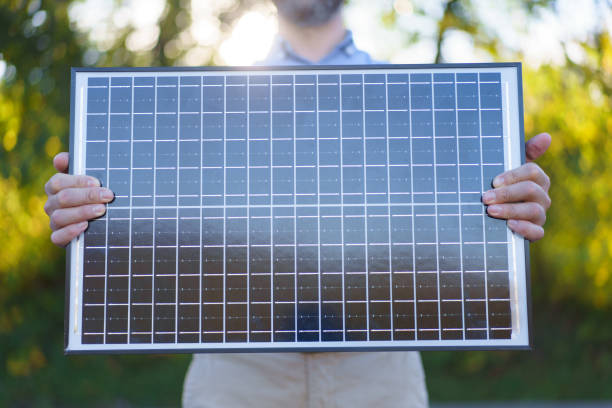
Understanding the dimensions of solar panels and the output of a solar panel system’s performance, quality, and efficiency will assist you in choosing the most suitable panels for your home. In general solar panels size is determined by the number of cells they hold. This complete guide on the size of solar panels will help you choose the dimension of the board.
HOW BIG ARE SOLAR PANELS?
Solar panels aren’t typically defined in meters. Instead, they declare the size of solar panels according to the number of cells it has. Solar cells are tiny squares made up of the components responsible for absorbing sunlight and then turning it into energy.
Standard solar cells measure six by 6 inches, and the dimensions of solar panels depend on the number of cells it comprises. The most commonly used size of solar panels is the 60 and 72-cell panels.
Standard Residential Solar Panels
Standard residential solar panels are usually 60-cell panels. The 6-cell-by-10-cell panels measure 5.4 by 3.25 feet or 65×39 inches. A 60-cell solar panel for residential use weighs 40 pounds; however,, some panels weigh as heavy as 50 pounds.
The dimension and weight of a panel vary by brand, so the manufacturer’s measurements are crucial to determine the dimensions. Panels with a 6-by-10 grid are homeowners’ most sought-after choice. They have the following rating:
Output By 2023, the typical home solar panel’s output will be 400 watts and higher.
Performance: Residential solar panels typically have a 19%- 22% efficiency.
Standard Commerical Solar Panels
For comparison, 72-cell panels are ideal for commercial use. Commercial solar panels generally have dimensions of 6.5 three feet, or 80×40 inches, on 6-cell grids of 12 cells, weighing around 50 pounds.
As with residential panels, commercial solar panels, a commercial solar panel’s dimensions are determined by their particular model. Because 72-cell panels are more than residential panels and have many more cells, they can generate more energy. They are equipped with the following features:
Output The typical commercial solar array produces between 400 and 500 watts. However, some 72-cell panels could have up to 580 watts.
Performance: These solar panels are usually between 18% and 21% efficient.
Panels With Half-Cut Solar Cells
Specific solar panels are built using half-cut cells composed of 120 (or 144) cells. Half-cut cells boost the surface area that can be converted into energy. One hundred twenty half-cut cells are similar to the standard 60-cell residential panel. Likewise, a 144-half-cut cell panel is the same as an ordinary commercial panel of 72 cells.
HOW TO DETERMINE HOW MANY SOLAR PANELS YOU NEED
A typical home or commercial structure requires between 15 and 19 solar panels to form an entire solar panel system that produces enough energy. The following aspects determine the precise number of meetings that a home requires:
Energy consumption A higher energy use means more excellent solar panels. considering how much electricity your commercial or residential property consumes is a perfect way to determine the boards you need.
Energy output: A solar panel’s wattage decides how much power it can generate. Discussions with lower power ratings can need you to install additional boards to create the energy the building consumes. Selecting panels with the highest power rating is best, so you can trust them to make the required power.
Locality: Location matters when determining the number of solar panels you require. Businesses and homes in warmer climates typically get more sunlight than other areas, allowing solar panels to take in more sunlight and convert energy using fewer panels.
Roof location: A south-facing, east-facing, or west-facing roof with little or shade permits solar panels to absorb the maximum sunlight and create higher energy levels than those facing north. Roofs that face south are the ideal place to install solar panels.
HOW TO PREPARE YOUR ROOF FOR SOLAR PANELS
Because solar panels weigh approximately 50 pounds, a complete solar panel system could weigh more than 700 pounds. While it may appear to be immense, many commercial and residential property roofs can withstand it. But, taking into consideration the condition of your roof is crucial.
If your business or home structure has an older roof, arrange an appointment with a professional for a check-up. There is a chance that you might have the replacement of your roof before installing a solar panel system, and an inspector will assist you in determining the need for a new roof. Required.
Professionals can put solar panels in any roofing in good condition. Additionally, they can install solar panels directly on the ground if you prefer to install an array of solar panels on your property.
OTHER IMPORTANT CONSIDERATIONS
Beyond the size of your solar panel and the condition of your roof, you must consider the following elements to help you select the correct solar panel configuration and setup:
Panel Efficiency: A panel’s efficiency rating determines whether it will supply power to your home or business while making the most savings on energy costs.
Output: A panel’s higher output rating higher how much energy can generate to power your home.
Mark: Choosing a reliable solar panel manufacturer is crucial. Brands that are reliable in their solar panel production will provide the efficiency and output you require and last longer than lesser-quality brands.
Support for systems: Purchasing solar panels from an organization that supports their products will give you quick access to repair and maintenance services as well as upgrades and battery backup solutions.
